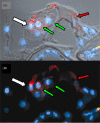Genetic and pharmacological intervention for treatment/prevention of hearing loss
- PMID: 18455177
- PMCID: PMC2574670
- DOI: 10.1016/j.jcomdis.2008.03.004
Genetic and pharmacological intervention for treatment/prevention of hearing loss
Abstract
Twenty years ago it was first demonstrated that birds could regenerate their cochlear hair cells following noise damage or aminoglycoside treatment. An understanding of how this structural and functional regeneration occurred might lead to the development of therapies for treatment of sensorineural hearing loss in humans. Recent experiments have demonstrated that noise exposure and aminoglycoside treatment lead to apoptosis of the hair cells. In birds, this programmed cell death induces the adjacent supporting cells to undergo regeneration to replace the lost hair cells. Although hair cells in the mammalian cochlea undergo apoptosis in response to noise damage and ototoxic drug treatment, the supporting cells do not possess the ability to undergo regeneration. However, current experiments on genetic manipulation, gene therapy, and stem cell transplantation suggest that regeneration in the mammalian cochlea may eventually be possible and may 1 day provide a therapeutic tool for hearing loss in humans.
Learning outcomes: The reader should be able to: (1) Describe the anatomy of the avian and mammalian cochlea, identify the individual cell types in the organ of Corti, and distinguish major features that participate in hearing function, (2) Demonstrate a knowledge of how sound damage and aminoglycoside poisoning induce apoptosis of hair cells in the cochlea, (3) Define how hair cell loss in the avian cochlea leads to regeneration of new hair cells and distinguish this from the mammalian cochlea where there is no regeneration following damage, and (4) Interpret the potential for new approaches, such as genetic manipulation, gene therapy and stem cell transplantation, could provide a therapeutic approach to hair cell loss in the mammalian cochlea.
Figures









References
-
- Adams JM, Cory S. The Bcl-2 protein family: Arbiters of cell survival. Science. 1998;281:1322–1326. - PubMed
-
- Bermingham NA, Hassan BA, Price SD, Vollrath MA, Ben-Arie N, Eatock RA, et al. Math1: An essential gene for the generation of inner ear hair cells. Science. 1999;284:1837–1841. - PubMed
-
- Cafaro J, Lee GS, Stone JS. Atoh1 expression defines activated progenitors and differentiating hair cells during avian hair cell regeneration. Developmental Dynamics. 2007;236:156–170. - PubMed
-
- Campbell K, Rybak L. Otoprotective agents. In: Campbell KCM, editor. Pharmacology and ototoxicity for audiologists. Thomson Delmar Learning; Clifton Park, NY: 2007. pp. 287–300.
Publication types
MeSH terms
Substances
Grants and funding
LinkOut - more resources
Full Text Sources
Medical

